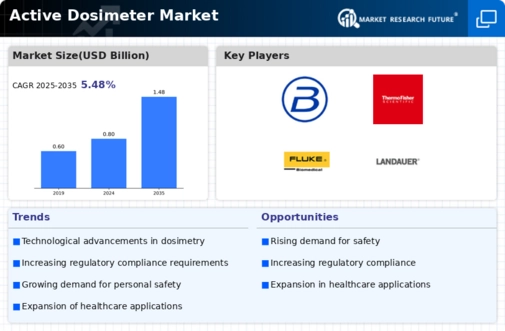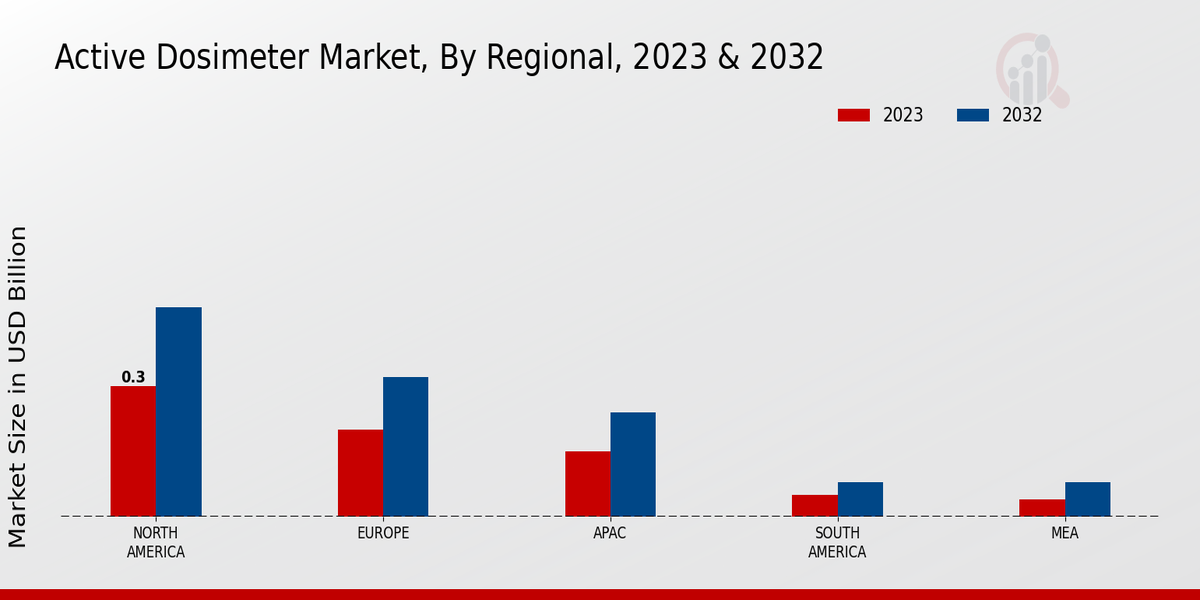Market Growth Projections
The Global Active Dosimeter Market Industry is anticipated to witness substantial growth over the next decade. With a market valuation of 0.8 USD Billion in 2024, projections indicate an increase to 1.48 USD Billion by 2035. This growth trajectory reflects a compound annual growth rate (CAGR) of 5.73% from 2025 to 2035. Factors contributing to this expansion include advancements in technology, increased regulatory compliance, and a heightened focus on occupational health and safety. The market's evolution is likely to be characterized by continuous innovation and the introduction of new products designed to meet the diverse needs of various industries.
Growth in Nuclear Energy Sector
The expansion of the nuclear energy sector serves as a vital driver for the Global Active Dosimeter Market Industry. As countries seek to diversify their energy sources and reduce carbon emissions, nuclear power emerges as a viable option. This growth necessitates robust radiation monitoring systems to ensure the safety of personnel working in nuclear facilities. The increasing number of nuclear reactors and the associated workforce heighten the demand for active dosimeters. Consequently, this sector is likely to contribute significantly to the market's projected growth, with an expected valuation of 1.48 USD Billion by 2035.
Regulatory Compliance and Standards
The Global Active Dosimeter Market Industry is significantly influenced by stringent regulatory frameworks aimed at ensuring radiation safety. Governments and international organizations establish guidelines that mandate the use of active dosimeters in various sectors, including healthcare and nuclear energy. Compliance with these regulations is essential for organizations to operate legally and safely. As regulations evolve, the demand for advanced dosimetry solutions that meet these standards is expected to rise. This regulatory landscape not only drives market growth but also encourages innovation in dosimetry technologies to align with the latest safety protocols.
Increasing Demand for Radiation Safety
The Global Active Dosimeter Market Industry experiences a notable surge in demand due to heightened awareness surrounding radiation safety. As industries such as healthcare, nuclear energy, and research laboratories expand, the necessity for precise radiation monitoring becomes paramount. In 2024, the market is valued at approximately 0.8 USD Billion, reflecting a growing recognition of the importance of protecting workers from radiation exposure. This trend is likely to continue, with projections indicating a market value of 1.48 USD Billion by 2035. The compound annual growth rate (CAGR) of 5.73% from 2025 to 2035 suggests sustained investment in active dosimetry technologies to ensure compliance with safety regulations.
Rising Awareness of Occupational Health
There is a growing emphasis on occupational health and safety across various industries, which positively impacts the Global Active Dosimeter Market Industry. Employers are increasingly recognizing the importance of monitoring radiation exposure to protect their workforce. This awareness drives the adoption of active dosimeters in sectors such as healthcare, manufacturing, and research. As organizations strive to create safer work environments, the demand for reliable radiation monitoring solutions is expected to rise. This trend aligns with the projected CAGR of 5.73% from 2025 to 2035, indicating a sustained commitment to enhancing occupational safety through advanced dosimetry technologies.
Technological Advancements in Dosimetry
Technological innovations play a crucial role in shaping the Global Active Dosimeter Market Industry. The introduction of advanced materials and digital technologies enhances the accuracy and reliability of dosimeters. For instance, the integration of wireless communication and real-time data transmission capabilities allows for immediate monitoring of radiation exposure. Such advancements not only improve user experience but also facilitate compliance with stringent regulatory standards. As a result, the market is poised for growth, with an anticipated increase in demand for sophisticated dosimetry solutions that can provide detailed insights into radiation levels in various environments.






